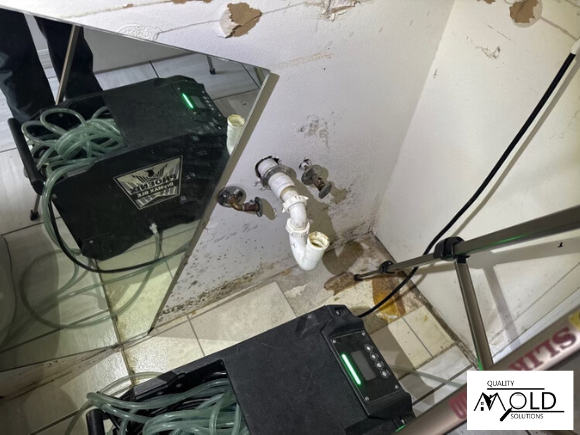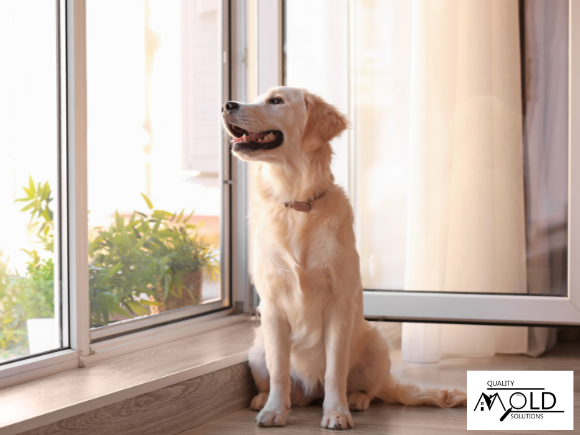Mold is a pervasive issue that can affect any home or business, leading to potential health risks and structural damage. Understanding how indoor mold formation occurs is essential for preventing and addressing mold problems. This blog explores the most common ways mold develops inside properties and highlights specific types of molds typically found in Florida, a region particularly susceptible to mold growth due to its humid climate.
What Causes Indoor Mold Formation?
 Moisture and Humidity
Moisture and Humidity
The primary factor contributing to indoor mold growth is moisture. Mold spores are ubiquitous and can be found virtually everywhere, but they require moisture to grow. High humidity levels, often above 60%, create an ideal environment for mold spores to thrive. In regions like Florida, where humidity is consistently high, maintaining indoor humidity levels below 50% is crucial to preventing mold growth.
Common Sources of Indoor Moisture:
- Leaks: Water leaks from roofs, pipes, windows, or other areas can introduce moisture into indoor spaces. Even small leaks, if left unaddressed, can lead to significant mold problems over time.
- Condensation: Condensation occurs when warm, moist air comes into contact with cool surfaces, such as windows, walls, or pipes. This moisture can provide a perfect breeding ground for mold.
- Poor Ventilation: Inadequate ventilation in areas like bathrooms, kitchens, and basements can trap moisture, promoting mold growth. Exhaust fans and proper ventilation systems are essential for reducing indoor humidity.
- Flooding: Flooding, whether due to natural disasters or plumbing failures, introduces large amounts of water into a property. Without prompt and thorough drying, mold can quickly take hold.
Organic Materials
Mold feeds on organic materials, making many common building materials and household items susceptible to mold growth. Materials such as wood, drywall, insulation, and carpeting provide the nutrients mold needs to thrive. When these materials become wet, mold spores can colonize them rapidly.
Inadequate Cleaning and Maintenance
Poor cleaning and maintenance practices can also contribute to mold growth. Dust, dirt, and organic debris can accumulate in hidden or hard-to-reach areas, providing mold with a food source. Regular cleaning, along with prompt repair of leaks and moisture issues, is essential for preventing mold formation.
In Florida, Indoor Mold Formation Comes in These Common Types
Florida’s warm and humid climate makes it particularly prone to mold growth. Several types of mold are commonly found indoors in this region, each with its own characteristics and potential health effects.
1. Aspergillus
Aspergillus is a common mold genus that includes many species, some of which are known to cause respiratory issues and allergic reactions. It often appears as green, white, or yellow patches on walls, ceilings, and other surfaces. Aspergillus thrives in damp environments and can be found in both indoor and outdoor settings.
2. Cladosporium
Cladosporium is another prevalent mold type in Florida. It typically appears as black, green, or brown spots on damp surfaces, including wood, textiles, and HVAC systems. Cladosporium can cause allergic reactions, asthma, and other respiratory issues, making it important to address promptly.
3. Stachybotrys Chartarum (Black Mold)
Stachybotrys chartarum, commonly known as black mold, is one of the most infamous and potentially hazardous molds. It produces mycotoxins that can lead to severe health problems, including respiratory issues, chronic fatigue, and neurological symptoms. Black mold thrives on materials with high cellulose content, such as wood, paper, and drywall, that have been exposed to moisture for prolonged periods.
4. Penicillium
Penicillium is a common indoor mold that can appear blue, green, or white. It often grows on water-damaged materials, including wallpaper, carpet, and insulation. Some species of Penicillium produce mycotoxins that can cause health issues, including respiratory problems and allergic reactions.
5. Alternaria
Alternaria is frequently found in damp areas, such as bathrooms, kitchens, and basements. It appears as dark green or black spots and can grow on a variety of surfaces, including walls, windows, and fabrics. Alternaria is a known allergen and can exacerbate asthma symptoms.
6. Chaetomium
Chaetomium is a mold often found in water-damaged buildings. It appears as cottony growths that change color from white to grey or brown over time. Chaetomium can produce mycotoxins and is associated with respiratory problems and immune system suppression.
Preventing Indoor Mold Formation
 Control Humidity Levels
Control Humidity Levels
Maintaining indoor humidity levels below 50% is crucial in preventing mold growth. Using dehumidifiers, air conditioners, and exhaust fans can help manage humidity levels, especially in high-moisture areas like bathrooms and kitchens.
Address Leaks and Moisture Issues Promptly
Regularly inspect your property for signs of leaks and water damage. Repair any leaks immediately and ensure that affected areas are thoroughly dried. Addressing moisture issues promptly can prevent mold from taking hold and spreading.
Improve Ventilation
Proper ventilation is key to reducing indoor moisture levels. Ensure that bathrooms, kitchens, and laundry areas are well-ventilated. Use exhaust fans during and after activities that generate moisture, such as showering and cooking.
Regular Cleaning and Maintenance
Keep your home clean and free of dust and debris that can provide nutrients for mold. Pay special attention to areas prone to moisture, such as basements, attics, and crawl spaces. Regularly clean and maintain HVAC systems to prevent mold growth in ducts and filters.
Use Mold-Resistant Products
When building or renovating, consider using mold-resistant materials, such as mold-resistant drywall and paint. These products are designed to inhibit mold growth and can be particularly beneficial in high-moisture areas.
Monitor Indoor Plants
Indoor plants can contribute to higher humidity levels and provide a habitat for mold. Ensure that plants are not overwatered and that there is proper drainage to prevent excess moisture. Regularly check the soil for signs of mold growth.


